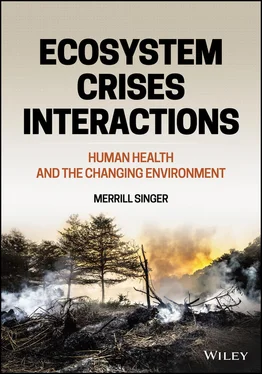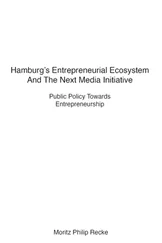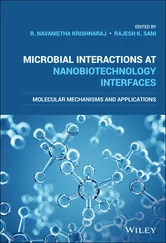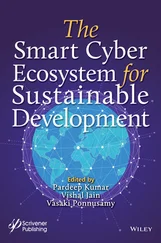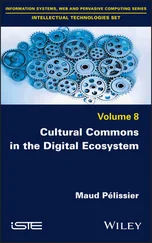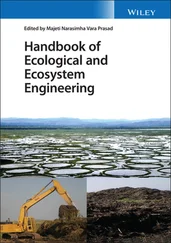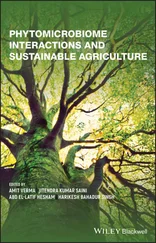105 Wilcox, B., Aguirre, A. & Horowtz, P. (2012). ECOHEALTH: connecting ecology, health, and sustainability. In: A. Aguirre, R. Ostfeld & P. Dsazak (Eds.), Conservation Medicine: Applied Cases of Ecological Health, pp. 17–32. Oxford: Oxford University Press.
106 Woolhouse, M. & Gowtage‐Sequeria, S. (2005). Host range and emerging and reemerging pathogens. Emerging Infectious Diseases 11: 1842–1847.
107 Yang, B., Qian, Z., Li, S., Chen, G., Bloom, M., Elliott, M., et al. (2018). Ambient air pollution in relation to diabetes and glucose‐homoeostasis markers in China: a cross‐sectional study with findings from the 33 Communities Chinese Health Study. Lancet Planetary Health 2(2): e64–e73.
108 Zalasiewicz. J., Waters, C., Williams, M., Barnosky, A. Cearreta. A., Crutzen, P. et al. (2015). When did the Anthropocene begin? A mid‐twentieth century boundary level is stratigraphically optimal. Quaternary International 383: 186–203.
109 Zalasiewicz, J., Waters, Colin, N., Wolfe, A., Barnosky, A., Cearreta, A. et al. (2017). Making the case for a formal Anthropocene Epoch: an analysis of ongoing critiques. Ingenta 50(2): 205–226.
110 Zinsstag, J., Schelling, E., Waltner‐Toews, D. & Tanner, M. (2010). From “one medicine” to “one health” and systemic approaches to health and well‐being. Preventive Veterinary Medicine 101(3–4): 148–156.
111 Zinsstag, J., Mackenzie, J., Jeggo, M., Hevmann, D., Patz, J. & Daszak, P. (2012). Mainstreaming one health. EcoHealth 9(2): 107–110.
Part 1 Impact on ecosystems
2 Intricacies of ecosystems
[E]cology, despite its fragmentary progress beginning with the environmental relations of plant life, is a study of the entire ecosystem. Of this this system, man is not just an observer and irresponsible exploiter but an integral part, now the world’s dominant organism. He has come into the system and survived thus far by the bounty of that system plus his own marvelous power of adjustment. Even so, the historical record is replete with his failure .
Paul Sears (1964, p. 4)
2.1 The nature of nature and the pathway to understanding
This chapter examines the nature of nature, specifically the interrelationships among species in an environmental context, as well as biodiversity and environmental regional and planet‐wide structures (e.g., air currents, hydraulics). The discussion begins with an introduction to the field of ecology and its conception of ecosystems in the world. The objective is to establish the deep connectivity in biotic/abiotic systems and identify threats to ecosystem sustainability, including the impacts these can have on species well‐being and survival. This exploration begins with a historic examination of the near and distant roots that fed the development of the science of ecology.
2.2 Developing a historic understanding of ecology and ecosystems
The term “ecology” is derived from the ancient Greek oikos , meaning “house” or “environment.” The field of ecology, as a specified domain or discipline of academic research, was defined in 1906 by Ernest Hackel, a German biologist, naturalist, and artist. He used the term “ecology” to label the rigorous science that seeks to comprehend the relations of organism to their surrounding environment, which includes “all conditions for existence” (quoted in Schulze et al . 2002, p. 1). As this meaning indicates, living organisms—even semi‐living entities like viruses, and certainly all plants and animals, including humans—cannot live without resources provided by the physical world immediately around them. The deeper roots of ecological study trace back to the natural history observations of revered ancient Greek philosophers like Herodotus, Aristotle, and Hippocrates, and even further back to the need of all indigenous people to know their environment, as life itself depended upon it.
Some of the earliest Western conceptions of the environment, such as ideas about nature being characterized by balance and internal regulation, have been attributed to Herodotus, though the word “ecology” does not appear in ancient Greek philosophical literature. Nonetheless, Herodotus provided one of the earliest written accounts of the relationship of mutualism, based on his observation of the way basking Nile crocodiles would open their mouths to give sandpipers safe access to remove leeches, which provided food for the birds and oral hygiene for the crocodiles (noted in Egerton 2001). Aristotle was an early influence on the philosophical development of ecology. He had a lifelong fascination with nature studies, and with his student Theophrastus, he carried out extensive observations on plant and animal migration, biogeography, physiology, and behavior (Hughes 1975, 1985).
Theophrastus had a long and productive life as a botanist, living to the age of 85. Following Aristotle’s death, he succeeded him as a director of the Lyceum in Athens, a position he held for 35 years. Founded by Aristotle, the Lyceum was called the Peripatetic School (from the Greek peripatos , “stroll”), apparently after Aristotle’s habit of meandering through its tree‐filled groves discussing philosophy, mathematics, and rhetoric with his eager students. The Lyceum embraced an organized and rigorous approach to the study of nature and is considered by some to have pointed the direction for the modern scientific method. Theophrastus arrived there at the young age of 17 and became a dedicated student and disciple of both Aristotle and his approach. Considered “the father of botany,” he conducted experiments and made and recorded observations on plant propagation, classification, physiology, and behavior. Unlike his teacher, however, he believed that animals could reason and therefore concluded that it was unethical to eat meat. Thus, he became a vegetarian and devoted his life to the study of vegetation.
As Hughes (1975) indicates, an underlying view of nature at the Lyceum, which became particularly pronounced in Theophrastus’ writings on plants, was an understanding of the physical world “as the theatre of reason,” a view “which made the beginnings of ecological thought possible.” In his various writings, especially De Historia Plantarum (The History of Plants) and the first five books of De Causis Plantarum (The Causes of Plants), Theophrastus (Long et al . 1985) describes plants as having three aspects. The first is their inner nature, which modern scientists trained in genetics would call their genotype, but he called telos , which means purpose or goal. The second aspect is their environment, including soil, moisture, temperature, exposure to the elements, wind, and elevation. Theophrastus believed the environment might support or act against a plant’s inner nature. Unlike later writers on the nature of nature, Theophrastus did not prescribe environmental determinism, but instead held an interactionist understanding of the distinctive features of plants and the distinctive features of their environments. Plants, he recognized, were adapted to local conditions, or what he called “mutation according to place.” Consequently, he believed plants must be studied in their normal setting, in what modern ecologists would call their natural ecosystem. Part of the environment of a plant, Theophrastus realized, was other plants. He noted that olive and myrtle trees, like pine and bay trees, tended to grow together, and he observed that close‐dwelling species might either compete with or benefit each other. Legumes, he understood, enrich the soil with nutrients absorbed by other plants. Ivy, however, kills the trees it grows on ( Fig. 2.1). Moreover, aware of Aristotle’s discussion of interspecies cooperation, he noted examples of birds contributing to the welfare of plants. Jays, for example, bury acorns, some of which sprout to grow new oak trees, which support jay populations. Thus, he was aware of the features of ecology now known as symbiosis and parasitism.
Читать дальше
